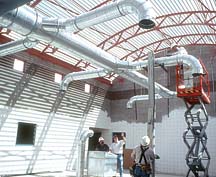On the outside chance the new homeowners are given an option to upgrade their HVAC system, the choices are usually limited. Perhaps they can choose a higher SEER unit or maybe a two-stage furnace, but that’s about it. Ductwork hardly ever figures into the upgrade scenario. Maybe that’s because it’s hidden, or maybe it’s because builders don’t know much about upgraded ductwork.
Of course, the best time to talk with customers about better ductwork is before the building is constructed. Once those walls are up, it doesn’t make much sense to go back in and rip everything out. The key is to find out how to communicate with customers while they’re making their upgrade decisions — with the builder’s blessing, of course.

Many Benefits
It’s pretty easy to explain the benefits of upgraded ductwork to the customer. The bottom line is that insulated ducts offer a more comfortable home. It will be warmer in winter and cooler in summer, with more uniform temperatures throughout the house, and the rooms will be quieter and more private. Any parent who sits in a second-story bedroom being rocked by a teenager’s music carried up from the basement through the air ducts will appreciate this concept.Unlike other expensive up-grades in a home, insulated ducts add a small fraction to initial construction costs. However, try to upgrade after construction is complete to solve an acoustical problem, for example, and it will be very costly. Although as Greg Mattix, product manager-mechanical insulations, CertainTeed Corp., Valley Forge, Pa., notes, “Duct board in general is an excellent application in a retrofit situation. It is relatively easy to fabricate with the proper hand tools and is more easily installed, especially in situations where space is at a premium.”
Eric Schakel, market manager, Air Handling Systems, Johns Manville, Denver, also sees benefits for contractors who offer upgraded duct products. “When you sell upgraded duct systems, you’re differentiating yourself from the competition. You’re also offering the opportunity to have a happier customer.”
He notes that many contractors believe that if they’re not bidding the lowest price on a job, they’re not going to get the job. “What they need to do instead is offer better service, provide a better system, and understand that by doing that, the homeowner ends up being more satisfied, even though they’ve paid more. Contractors can get a higher margin for their work by offering a higher cost alternative,” notes Schakel.

“We have a contractor in Gainesville, Fla., with a showroom. He has little rooms where you can sit in recliners and listen to different units through different kinds of duct. Conditioned air comes out of these ducts, and you can hear the difference between them. He says if he can get people to come to his showroom, he can get an upgrade every time,” says Schakel.
Tom Haas, Pro Air Conditioning, Port Charlotte, Fla., says many homeowners are enthusiastic about some of the newer high-performance fiberglass duct board systems that are available. “Once they see what is available, in terms of tough airstream facing and moisture-repellent properties, they want to replace not only the A/C equipment, but also the entire duct systems.”
It still may be difficult to convince builders to offer homeowners a chance to upgrade their ductwork. That’s compounded by the fact that most end users are not even aware that an upgrade in thermal and acoustical performance is available. They know they want this performance, but they don’t know what to ask for to get it. So, the demand exists — it’s just a question of getting the builders to understand why upgraded ductwork should be offered.
Of course, designing the ductwork correctly can also alleviate a lot of problems. Schakel states that contractors often try to run too much air through too little ducting, which results in balance and noise problems throughout a house. Sealing the ductwork is also a good idea, because it provides benefits from an energy point of view.

What’s Available
In many parts of the country a “standard” duct product is bare sheet metal rectangular duct. Even flex duct systems require a certain amount of sheet metal. Many types of insulation products are available to upgrade the basic sheet metal duct offering.Manufacturers assert that fiberglass duct liners and duct board offer customers three advantages over sheet metal. The first is better thermal control. Insulated ducts are designed to deliver conditioned air to the registers with almost no change in temperature. The second is energy reduction. Efficient delivery means there is no need to overheat or overcool the air to achieve desired temperatures.
The third advantage is often the most obvious and desirable to the customer: sound attenuation. Bare sheet metal transmits noise, such as the sound of the HVAC fan or cross talk from one room or floor to another. Additionally, sheet metal can make clicking noises of its own as the system cycles on and off. Insulated duct practically eliminates this noise transmission, giving occupants a much more comfortable, quiet home or office. Incidentally, this can reduce callbacks for contractors.

Johns Manville’s highest level upgrade is ductwork fabricated from fiberglass duct board, such as SuperDuct® or Mat-Faced Micro-Aire® duct board. Duct board eliminates the need for sheet metal altogether and is a fully sealed system, so leakage is never an issue.
CertainTeed’s upgraded duct liner products include ToughGard duct liner with Enhanced Surface, a textile product; ToughGard R duct liner with Enhanced Surface, a rotary liner; and ToughGard rigid liner board, which also serves as an acoustical liner. The manufacturer also offers upgraded duct board, ToughGard duct board with Enhanced Surface.
It’s really a pretty simple concept, says Schakel. “Residential, commercial, and institutional end users all benefit from insulated duct systems. Homeowners enjoy more comfortable temperatures and quieter rooms. For commercial and institutional occupants, these benefits extend to improved productivity on the job and in the classroom. And we’re talking about very small increased costs.”
Publication date: 09/29/2003


